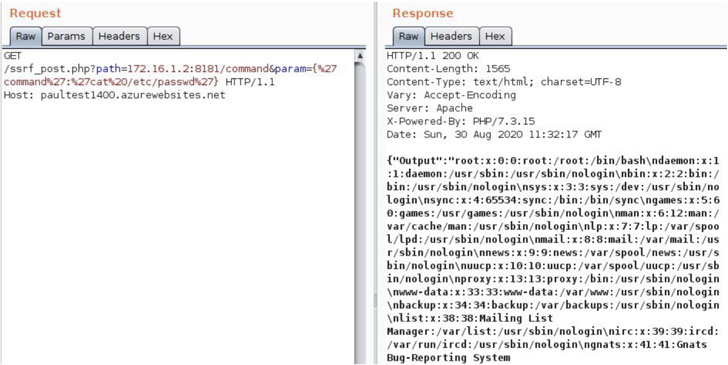As businesses are increasingly migrating to the cloud, securing the infrastructure has never been more important.
Now according to the latest research, two security flaws in Microsoft's Azure App Services could have enabled a bad actor to carry out server-side request forgery (SSRF) attacks or execute arbitrary code and take over the administration server.
"This enables an attacker to quietly take over the App Service's git server, or implant malicious phishing pages accessible through Azure Portal to target system administrators," cybersecurity firm Intezer said in a report published today and shared with The Hacker News.
Discovered by Paul Litvak of Intezer Labs, the flaws were reported to Microsoft in June, after which the company subsequently addressed them.
Azure App Service is a cloud computing-based platform that's used as a hosting web service for building web apps and mobile backends.
When an App Service is created via Azure, a new Docker environment is created with two container nodes — a manager node and the application node — along with registering two domains that point to the app's HTTP web server and the app service's administration page, which in turn leverages Kudu for continuous deployment of the app from source control providers such as GitHub or Bitbucket.
Likewise, Azure deployments on Linux environments are managed by a service called KuduLite, which offers diagnostic information about the system and consists of a web interface to SSH into the application node (called "webssh").
The first vulnerability is a privilege escalation flaw that allows for a takeover of KuduLite via hard-coded credentials ("root:Docker!") that makes it possible to SSH into the instance and log in as root, thereby allowing an attacker complete control over the SCM (aka Software Configuration Management) webserver.
According to the researchers, this could enable an adversary to "listen to a user's HTTP requests to the SCM web page, add our own pages, and inject malicious Javascript into the user's web page."
The second security vulnerability concerns the way the application node sends requests to the KuduLite API, potentially permitting a web app with an SSRF vulnerability to access the node's file system and steal source code and other sensitive assets.
"An attacker who manages to forge a POST request may achieve remote code execution on the application node via the command API," the researchers said.
What's more, successful exploitation of the second vulnerability implies the attacker can chain the two issues to leverage the SSRF flaw and elevate their privileges to take over the KuduLite web server instance.
For its part, Microsoft has been steadily working to improve security in the cloud and the internet of things (IoT) space. After making available its security-focused IoT platform Azure Sphere earlier this year, it has also opened it up for researchers to break into the service with an aim to "identify high impact vulnerabilities before hackers."
"The cloud enables developers to build and deploy their applications at great speed and flexibility, however, often the infrastructure is susceptible to vulnerabilities out of their control," Intezer said. "In the case of App Services, applications are co-hosted with an additional administration container, and [...] additional components can bring additional threats."
"As a general best practice, runtime cloud security is an important last line of defense and one of the first actions you can to reduce risk, since it can detect malicious code injections and other in-memory threats that take place after a vulnerability has been exploited by an attacker."
Found this article interesting? Follow THN on Facebook, Twitter and LinkedIn to read more exclusive content we post.
.png)
 4 years ago
153
4 years ago
153 
















 Bengali (Bangladesh) ·
Bengali (Bangladesh) ·  English (United States) ·
English (United States) ·